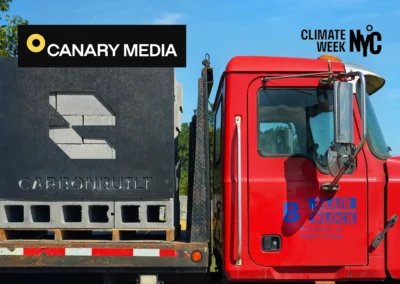From low carbon concrete to fuels, CO2 from the air can replace CO2 from the ground.
David Roberts (@drvolts) | Original Article: Vox
It is well understood at this point that carbon dioxide is a deadly pollutant that is heating the atmosphere. What’s less well understood is that CO2 is also a useful feedstock, an input into a variety of industrial processes. From plastics to low carbon concrete, CO2 is a basic industrial building block — a valuable commodity.
To many climate campaigners, this suggests that maybe we should use more of it. Maybe, if the industries that use CO2 could be incentivized to increase their use, we could use enough to substantially decrease the amount we emit into the atmosphere.
Use more; emit less. That is the basic idea behind carbon capture and utilization (CCU), one of the hottest topics in clean energy these days.
In my first post in this series, I introduced the concept of CCU and its basic forms. In the second, I took a close look at what is currently the most common industrial use of CO2, namely enhanced oil recovery (EOR), whereby CO2 is injected in spent wells to squeeze out more oil and gas. (It’s complicated.)
In this post, we’re going to take a look at the other industrial uses of CO2 to try to get a sense of how viable they are, what their total potential might be, and whether they might play a significant role in the fight against climate change. Fun times!
One important note: For the purposes of this post, I’m looking at industrial processes. They involve pulling CO2 out of the air — either out of the flue gases of industrial facilities, via traditional carbon capture, or out of the ambient air, via direct air capture (DAC) — concentrating it, and using it as industrial feedstock.
There are also a number of natural ways of gathering more CO2, from planting more forests to sequestering more carbon in the soil. They are interesting and of potentially significant scale, but they deserve their own post. This post is about machines.
:no_upscale()/cdn.vox-cdn.com/uploads/chorus_asset/file/12901251/carbon_engineering.jpg)
Three important ways to assess CCU technologies
Before we get into the various forms of CCU, let’s keep in mind three important questions we need to be asking about all of them as we take their measure.
The questions are drawn from a giant literature review on CCU, recently released in the journal Nature, which assessed over 11,000 papers and was accompanied by an expert opinion survey. It helps bring into clear focus the key metrics involved in appraising these technologies.
The first question is, does the CCU technology produce a climate benefit? Does it reduce carbon emissions, and if so, how much? Does it sequester carbon, and if so, for how long?
There are a few overlapping concepts here that are often conflated in popular dialogue, so it’s worth distinguishing them. Here’s how the Nature paper does it:
- CO2u: utilization of CO2
- CO2ρ: reduction in CO2 emissions relative to baseline
- CO2r: removal of CO2 from the atmosphere
- CO2s: storage of CO2
:no_upscale()/cdn.vox-cdn.com/uploads/chorus_asset/file/19104348/royalsoc_ccu_uses.png)
Different CCU technologies involve different mixes of these. Determining the net carbon impact of a CCU technology involves life-cycle analysis (LCA) that takes into account where the CO2 is sourced, how much energy is used in production, where the energy comes from, how much CO2 is released during production, whether any of the released CO2 is captured, how the product is eventually disposed of, and what would have taken place in the absence of the production. (LCA is devilishly complicated and there are currently no widely shared standards governing how it’s done.)
Some uses of CO2 — say, making liquid fuels that substitute for gasoline and diesel fuel — only lock in carbon until the fuel is combusted, at which point it is re-released into the atmosphere. They don’t remove CO2 from the atmosphere so much as recycle it once and then put it back; the Nature paper calls them “cycling” processes. But by substituting a carbon-neutral process for a carbon-intensive one, they reduce net emissions (CO2ρ) relative to what would have happened otherwise.
Other uses of CO2 — say, as part of the cement-production process — lock in carbon for much longer. Concrete won’t permanently keep CO2 out of the atmosphere, but could plausibly store it for a century or longer, so for all intents and purposes it counts as carbon storage (CO2s). The Nature paper calls these “closed” processes.
LCA is complex, and the details matter, but one broad conclusion from the literature is that “the potential for net emission reductions is much larger than for net removals, which appears very modest.” Overall, CCU probably won’t result in a lot of CO2s, but it could produce considerable CO2ρ.
Assessing the climate benefit of different CCU options is paramount. Policymakers should always keep in mind that CCU is not a good in and of itself. It is only worth pursuing insofar as it makes a meaningful climate difference.
The second question is, what is the potential scale of the CCU technology? If it’s a specialized or low volume product, it might not be worth the R&D effort to figure out how to make it work commercially with captured CO2. It stands to reason that policymakers and investors should prioritize their attention and resources based on the technologies with the largest total potential. (We’ll look at a ranking of technologies by potential in a moment.)
And the third question is, how far along is the CCU technology on the learning curve? Is it a speculative technology that exists mostly in the lab and a few pilot projects, like synthetic liquid fuels, or is it an established technology with near-term potential for market growth, like CO2 in cement?
All these questions are important in assessing the potential of CCU technologies to provide practical climate solutions.
So what are those technologies? Let’s take a look at a few.
:no_upscale()/cdn.vox-cdn.com/uploads/chorus_asset/file/19372447/nature_ccu_chart.png)
(There are lots of different ways of dividing them up; my list is a bit of a mash-up of the Nature paper referenced above and this exhaustive 2016 roadmap conducted by Lux Research for the Global CO2 Initiative.)
1. Low carbon concrete building materials
There are several technologies here, all related to concrete, which is a mix of cement, water, and aggregates. The cement is a fine powder that, when activated by the water, binds the aggregates into a rigid mix.
First, aggregates — which are incorporated into concrete, asphalt, and construction fill — can be made by converting gaseous CO2 into solid mineral carbonates like calcium carbonate (CaCO3), a process known as “CO2 mineralization.” (See Blue Planet.)
Second, CO2 can be substituted for water in “curing” concrete during its mixing, resulting in a similar mineralization. It turns out this actually makes the resulting low carbon concrete stronger, in addition to saving lots of water. (See, for example, CarbonBuilt, Solidia and CarbonCure.)
Third, cement can be phased out in favor of new binding agents that absorb and mineralize CO2. (See CO2 Concrete.)
Fourth, and most speculative, is a promising tech being pushed by the EU’s Low Emissions Intensity Lime & Cement (LEILAC) project. The production process for cement and lime involves chemical reactions (not fossil fuel combustion) that inevitably release CO2. LEILAC seeks to tweak the process so that it creates a purified CO2 waste stream that can easily be captured and either sequestered or reused.
At least in theory, one can imagine purified CO2 emissions from the cement manufacturing process captured and then re-injected into the process as a CO2-mineralizing bonding agent is mixed with CO2-based aggregates. If all those pieces could be lined up — and to be clear, that’s not being done anywhere in the world yet — the resulting building materials might have a claim to being truly carbon negative, on a lifecycle basis. They would not only reduce net emissions (CO2ρ), they would semi-permanently store carbon (CO2s).
But short of that, even if cement achieves only CO2ρ, not CO2s, the opportunity here is large and immediate. These technologies (at least the first two) are established and relatively low energy; they could potentially result in carbon sequestration on the scale of billions of tons.
2. Liquid fuels
Today, liquid fuels — gasoline, diesel, and more rare variants like jet fuel — are made by refining hydrocarbons drilled from underground. They can be made with carbon from the air instead.
“Synthetic fuels” can be made in many different ways, through many different processes and chemistries, resulting in a variety of fuels. There are synthetic fuels that can substitute for any liquid fuel.
The simplest way to think about them is as a mix of three things: a carbon-based molecule (usually CO2), hydrogen, and energy. The energy is used to pry the oxygen off the carbon and stick the carbon onto the hydrogen. Thus “hydrocarbons.”
The carbon intensity of the resulting fuels depends on the source of all three components: the CO2, the electricity, and the hydrogen.
If the CO2 comes from underground deposits, the electricity comes from fossil fuels, and the hydrogen comes from steam reforming of natural gas (as roughly 95 percent of hydrogen does today), the resulting fuel is extremely carbon intensive.
If the CO2 comes from the ambient air, the electricity comes from renewables, and the hydrogen comes from solar-powered electrolysis (which pulls hydrogen directly out of water), the resulting fuel is extremely low carbon.
Carbon-neutral liquid fuels are almost certainly the largest potential market for CO2. There are lots of liquid fuels in the world, and there are existing markets for cleaner alternatives, including in states like California and Oregon with a low-carbon fuel standard (LCFS).
:no_upscale()/cdn.vox-cdn.com/uploads/chorus_asset/file/10223563/hytech.jpg)
Reducing the cost of carbon capture would help with synthetic fuels, but it’s the other two ingredients, hydrogen and energy, that represent a larger portion of the costs. It takes a lot of energy to electrolyze hydrogen and it takes even more to pry CO2 apart. (CO2 is tightly bonded; it doesn’t want to come apart.) All that energy costs money.
Extremely cheap renewable energy is the key to making carbon-neutral synthetic fuels work because it is the key to cheap hydrogen, and producing synthetic fuels at scale is going to require a lot of hydrogen. In a special report on difficult-to-decarbonize sectors like industry and air travel, the Energy Transitions Commission emphasized the need for synthetic fuels, and thus the need for hydrogen: “Achieving a net-zero-CO2-emissions economy will require an increase in global hydrogen production from 60 [megatons] per annum today to something like 425-650 Mt by mid-century.”
Even if hydrogen doesn’t play a big direct role in transportation (it probably won’t), it will still be needed for synthetic fuels, which are themselves needed to decarbonize hard-to-reach sectors like industry. To make electrolysis of “green hydrogen” possible, renewable energy needs to get real cheap.
There are plenty of analysts who think that utility-scale solar power in good locations will be producing the cheapest electricity in the world soon, down to $20 or even $10 per megawatt-hour. And there will be periods of surplus solar energy that need to be soaked up, energy that might otherwise have gone wasted.
“Although the production of more complex hydrocarbons is energetically and therefore economically expensive,” says the Nature paper, “rapid cost-reductions could potentially occur if renewable energy—which represents a large proportion of total cost—continues to become cheaper, and if policy stimulates other cost reductions.”
Synthetic fuels effectively don’t exist today on any kind of market scale (“current flows are near-zero,” as the Nature paper says), but if everything comes together to support them, they could conceivably capture a substantial chunk of the global fuels market, which is no small thing. It’s not CO2s, but it’s a whole lot of CO2ρ.
To be clear: the future is electrification. When it comes to decarbonization, it is always better to electrify the end uses of energy — to use the electricity directly, rather than losing a large fraction of it to conversions — but even under optimistic scenarios, there are going to be sectors that are difficult to electrify.
Carbon-neutral liquid fuels for sectors that are difficult to decarbonize are both a large market and a key piece of the decarbonization puzzle.
:no_upscale()/cdn.vox-cdn.com/uploads/chorus_asset/file/6598855/mit-solar-fuels.png)
3. Chemicals and plastics
Using various catalysts, CO2 can be made into a variety of chemical intermediaries — materials that then serve as feedstocks in other industrial processes, like methanol, syngas, and formic acid.
CO2 can also be transformed by catalysts into polymers, the precursors for plastics, adhesives, and pharmaceuticals. For now, CO2 derived polymers are quite expensive, but plastics are another potentially substantial market — they represent a growing fraction of demand for liquid fossil fuels. And they have a lifespan of decades to centuries, so they present some potential for CO2s.
Currently, only a few chemical applications of CO2 are commercialized at scale, including the production of urea and polycarbonate polyols.
4. Algae
Captured CO2 can be used to accelerate the growth of algae, which has the capacity to absorb much more of it, much faster, than any other source of biomass. And algae is uniquely useful. It can serve as feedstock for food, biofuels, plastics, and even carbon fiber (see No. 5). It’s worth noting that around five years ago, algae was seen as a kind of wonder-plant, but the sector hasn’t really taken off and a lot of the early companies have gone under.
5. Novel carbon materials
Here’s where we find more speculative, cutting-edge, but potentially momentous markets. CO2 can be made into high-performance materials — carbon composites, carbon fiber, graphene — that could conceivably substitute for a whole range of materials, from metals to low carbon concrete.
For instance, the team at C2CNT is using “molten electrolysis” to transform CO2 directly into carbon nanotubes, which are stronger than steel and highly conductive. They are already used in high-end applications like the Boeing Dreamliner and some sports cars. But as they become cheaper, there is almost no ceiling to the market.
To take just one example, think of substituting carbon nanotubes for copper in electricity wiring. (Thanks to Adam Siegel for pointing out this idea.) Virtually every application of electricity, from the space station to electric vehicles to household appliances, would benefit from lighter-weight wiring that conducts better.
And then there’s steel, the most commonly used metal in the world, responsible for between 7 and 9 percent of global CO2 emissions from fossil fuels. If carbon-based materials could be substituted for steel on any real scale, it could mean billions of tons of reduced emissions, not to mention effectively permanent carbon sequestration.
Of course, this kind of materials research is still in its early stages and will take some technological breakthroughs to bring down costs enough to begin displacing other materials at scale. For now, carbon materials are getting a foothold in boutique markets.
Comparing CCU technologies on cost and potential
The Nature paper compared 10 different CCU pathways, including the natural ones, which I’ve excluded here, and EOR, which I covered in my last post. So the chart below contains some extraneous information for our purposes. Nonetheless, it’s worth examining closely, as it shows the pathways by costs, the potential for CO2 use, and technological readiness (TRL). There are two scenarios, reflecting the low end and high end of projections.
:no_upscale()/cdn.vox-cdn.com/uploads/chorus_asset/file/19372413/nature_ccu.png)
Zero on the vertical axis is the present-day “breakeven cost” (in 2015 dollars), the point at which a technology is competitive with incumbents. Those below that line are already competitive. Those above the line would need a commensurate subsidy of some kind to compete.
The width of the bars indicates the amount of CO2 the technology could utilize annually by 2050 (based on projections and expert opinion). And the color of a bar indicates its TRL.
Based on the optimistic high scenario, a few of the chemical pathways (polyol, urea, and methanol) are already cost-competitive, though their potential for CO2 use is relatively small, close to a gigaton cumulatively.
The pathways to low carbon (aggregates and curing) are fairly close to cost-competitive and curing in particular has fairly large potential, especially when you consider that its CO2 counts twice, once as emission reductions, once as permanent storage.
Troublingly, the industrial CCU technology pathways with the most total potential to use CO2 are the most expensive relative to incumbents.
Together, synthetic liquid fuels (methanol, methane, dimethyl ether, and Fischer–Tropsch fuels) could use over 4 gigatons of CO2 a year by 2050. (By way of comparison, global CO2 emissions in 2018 were about 37 gigatons.) But they currently need something like a $500 per ton of CO2 subsidy to compete.
Nevertheless, as the Nature paper says, “many technologies are in the very early stages of development, and cost optimization via research and development could substantially change these estimates.” If there’s one target for concerted R&D that seems obvious, it’s synthetic fuels.
Here’s the same information in table form, if that’s your thing:
:no_upscale()/cdn.vox-cdn.com/uploads/chorus_asset/file/19372429/nature_ccu_table.png)
One thing the table makes clear is that the ranges on some of these projections are extremely wide ($0 to $670?), reflecting the enormous degree of uncertainty involved.
How these CCU technologies develop will depend on the price curve of renewable energy, the price curve of green hydrogen, developments in a range of markets, and the level of R&D and policy support they receive from lawmakers. All those are individually difficult to predict; sussing out how they might interact through 2050 is a game of educated guessing.
Carbon capture and utilization can do more if there’s policy to support it
The Nature paper’s conclusions reflect the average of a huge number of studies and experts, attempting to determine current costs and what will happen.
But it’s worth taking at least a quick glance at some more optimistic estimates of what could happen with supportive policy.
In 2016, the Global CO2 Initiative commissioned a comprehensive roadmap for CCU from Lux Research. It not only projected how CCU technologies might scale under business as usual, but also how they might scale if the policy recommendations in the roadmap are followed.
Here’s how the roadmap assesses the CO reduction potential of various CCU technologies:
:no_upscale()/cdn.vox-cdn.com/uploads/chorus_asset/file/19124937/cbpi_roadmap_potential.png)
As you can see, following the “strategic actions” recommended by the report could radically expand the CO2 absorption potential of both aggregates and synthetic fuels. The roadmap estimates that, at the upper bound, “over 10% of annual [global] CO2 emissions can be captured in these products.”
Here’s the total revenue potential of the CCU markets:
:no_upscale()/cdn.vox-cdn.com/uploads/chorus_asset/file/19124943/cbpi_roadmap_revenue.png)
Again, fuels and aggregates show enormous potential, growing ten- or twenty-fold more under good policy. The roadmap estimates that overall, annual revenue of the combined markets could hit between $800 billion and $1.1 trillion by 2030.
As I said, all of these are tenuous estimates, but still, if CCU technologies could potentially develop into a $1 trillion-plus business that cuts global emissions by 10 percent, they seem worth serious investment of attention and resources. The more we can use, the less we will emit.




